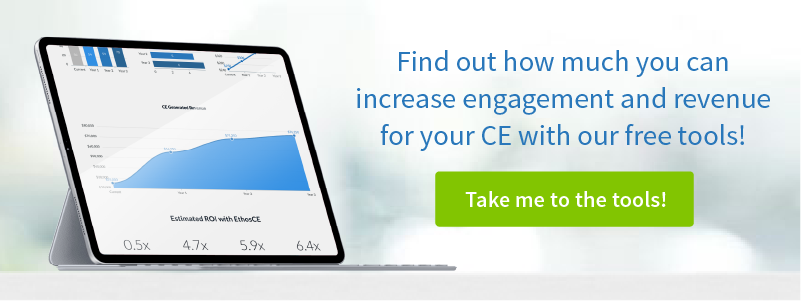Is Interactive Video Right for Healthcare Continuing Education?
In the past few weeks I’ve written roundups of both commodity and enterprise video providers for healthcare continuing education providers. So what’s next? Interactive video!
Interactive video allows content, such as hotspots, text, forms, images, polls or quizzes, to appear on top of video. Instead of passively watching the video, the viewer can interact with it and change what’s going to happen next. Viewers are rewarded with more relevant content and educational providers gain increases in viewer engagement and knowledge retention.
If you haven’t experienced interactive video yet, stop reading and try it now. Here are a few examples.
- http://corp.hapyak.com/examples/interactive-example
- http://www.raptmedia.com/customers/warner-bros-focus/
- https://www.playposit.com/share/53305/180271
Why a Should Healthcare Continuing Education Provider Use Interactive Video?
Engagement.
Interactive video requires the learner to participate, and, by doing so, they make the content more relevant to their needs.
Improvement.
Interactive video allows content authors and education providers to gain a wealth of information about what learners are watching and where they drop off. That information can be used to iterate and improve content. Interactive elements can ensure the video isn’t just playing while the learner is doing something else.
Outcomes.
Learners watching interactive video have been shown to have improved outcomes over non-interactive video. A 2006 study investigated whether interactive video enhances the learner’s understanding and improves learning effectiveness and found the “post-gain of the e-learning group with interactive video … was significantly higher than that of the other three groups.” A 2016 study on autism training in medical education found an increase in the achievements of students who watched interactive video. “Watching interactive videos was shown to positively affect medical students’ decision-making process,” the study reported.

What Features of Interactive Video can Healthcare Continuing Education Providers Use?
Menus and chaptering
Learners can easily jump to the content they are most interested in with menus and chaptering in a video. This would work nicely with an enduring version of a live meeting, such as a virtual annual meeting. Learners can jump between sessions without leaving the video player.
Storytelling & case studies
Interactive video can be used for narrative storytelling. In healthcare continuing education, imagine a physician CME patient case-study activity. Each step of the case can be controlled by interactive video decision points. The “patient” can react to the narrative selected by the learner.
Text-based callouts and content
Text-based callouts and content can be used to label and define complex technical videos.
Evaluations, polls and surveys
Education providers in healthcare continuing education can use interactive video to collect feedback about the in presentation itself.
Assessment and Quizzes
In addition to simply testing knowledge, assessment questions can be used to change what’s going to happen next. If a learner misses a question, the video can then go to the relevant area of content where the topic is being taught.
Who Provides Interactive Video Platforms for Healthcare Continuing Education?
The number of vendors is small, and as in our previous video provider blogs, we are only listing providers that focus on education or have it as a primary market.
HapYak provides “interaction, analytics and integration” for all your videos. Located in Boston, HapYak’s authoring platform is browser-based and supports rich interactive features such as hotspots, images, quiz questions and more. While the authoring tools are not quite as slick as Rapt, it is easy to learn and use. HapYak partners with video hosting providers such as Brightcove, Kaltura, Wista and others, and also has integrations with LMS platforms.
PlayPosit is focused on K-12 and secondary education but also offers corporate solutions which are appropriate for continuing education healthcare providers. The authoring interface is simple to use and PlayPosit has integrations with learning management systems available for their premium accounts. Backed by AT&T and Stanford’s startX, PlayPosit is the lowest cost of all the providers reviewed, but the integration with Google classrooms may be a bit off-putting for some.
Rapt Media provides an easy-to-use platform with a focus on e-learning and education. Located in Boulder, Colorado, Rapt offers a compelling browser-based drag-and-drop product for authoring and also provides hosting and streaming services as well as analytics and an API for developers. Rapt doesn’t offer quiz questions as a content type, but they can be created in the video manually. Rapt offers a standalone product and also has an integration with Kaltura.
EthosCE is the industry-leading, SCORM-compliant learning management system designed to automate and modernize the delivery of continuing education in the health professions. We work closely with leading medical association, academic centers, and health system to optimize their technology infrastructure and create an easy-to-use and intuitive environment for learners and CME administrators alike. For more information about our EthosCE, please contact us at 267-234-7401.
 We're now part of the Cadmium product suite! Learn more
We're now part of the Cadmium product suite! Learn more 






You shared good information. I like you article because now a days everyone looks for latest technologies and easy done.Thanks for it…..In today’s digital era… Medical Science reached on each hand via mobile application. Hospital Management System is the finest application from which you can handle all your work regarding health issue able to handle from single click
Comments are closed.